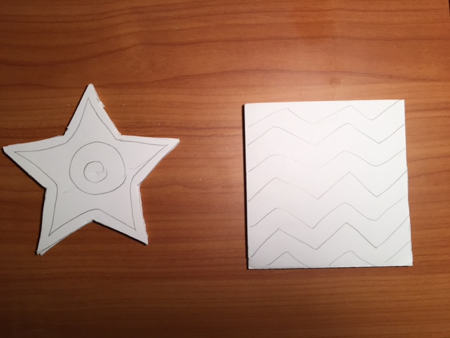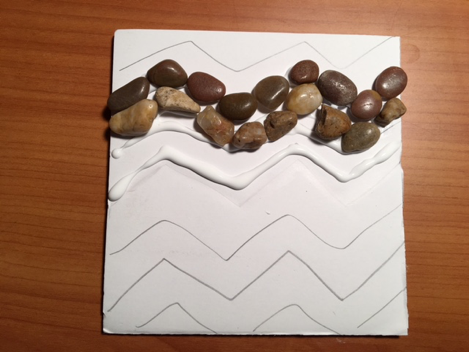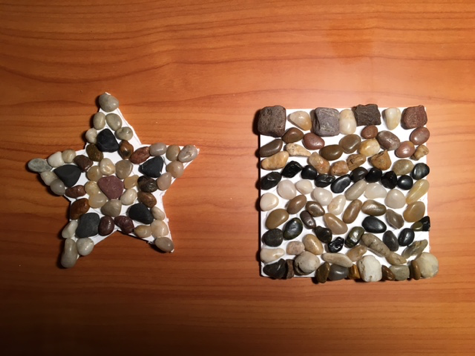Students create patterns with rocks to form a mosaic. Recommended for 1st Graders.
Pattern: a principle of design; the repetition of the elements of visual arts in an organized way; pattern and rhythm are both created through repetition; see rhythm for examples of regular, alternating, random, and progressive rhythmic patterns.
Repetition: the repeated use of particular elements of visual arts to create a pattern, movement, rhythm, or unity.
Variation (variety): the use of the elements of visual arts to create differences in an artwork for visual interest.
Refer to the Pattern/Repetition/Variety Reference Page for more information and examples.
Mosaic: An artwork made from small pieces of colored glass, stone, paper, or other materials.
Mosaic is the art of creating images with an assemblage of small pieces of colored glass, stone, or other materials. The earliest known examples of mosaics made of different materials were found at a temple building in Ubaid, Mesopotamia, and are dated to the second half of 3nd millennium BCE. They consist of pieces of colored stones, shells and ivory. Excavations at Susa and Choqa Zanbil show evidence of the first glazed tiles, dating from around 1500 BCE.
Mosaics of the 4th century BCE are found in the Macedonian palace-city of Aegae and they enriched the floors of Hellenistic villas, and Roman dwellings from Britain to Dura-Europos. Splendid mosaic floors are found in Roman villas across north Africa, in places such as Carthage, and can still be seen in the extensive collection in Bardo Museum in Tunis, Tunisia. The most famous mosaics of the Roman world were created in Africa and in Syria, the two richest provinces of the Roman Empire. Many Roman mosaics are found in Tunisian museums, most of which date from the second to the seventh century CE.
Mosaics from Ancient Mesopotamia date back to 3rd Century B.C.E. Stone , ivory and shells were used to create the early mosaics.
Cut cardboard/foam core into squares or other shapes (approx. 5x5”) – one per student.
Pour glue into small cups and place popsicle stick or cotton swab in container.
Explain to students they can sketch lines that are zigzag, wavy or straight.
Math can be a discussion point by counting how many rocks it takes to complete a certain pattern.
Students can discuss what patterns they made.
Students can point to repeated patterns and variations in the pattern
Students can describe mosaics as an art form that is made from small pieces of colored glass, stone, paper, or other materials.



http://www.cfisd.net/en/parents-students/academics/course-descriptions/elementary-art/glossary-art-terms-k-5/, http://www.incredibleart.org/files/elem_vocab.html, http://arthistoryresources.net/ARTHLinks.html, http://arthistory.about.com/, https://www.ancient.eu/Mosaic/
21st Century Thinking Skills
Thinking Flexibly, Persisting, Problem Solving, Sequencing, and Classifying.
WA State Learning Standards
(VA:Cr1.2.1) Generate and conceptualize artistic ideas and work. Use observation and investigation in preparation for making a work of art. Gather, explore, and thoughtfully select materials for use.
(VA:Cr3.1.1) Refine and complete artistic work. Use art vocabulary (pattern, repetition, variation) to describe choices while creating art.
(VA:Cn11.1.1) Relate artistic ideas and works with societal, cultural, and historical context to deepen understanding. Understand that people from different places and times have made art for a variety of reasons.
Arts Integration Opportunities
Math: Geometry or pattern lesson.
History.
Geology/Earth Science connection with rock classification.
Please note: These lesson plans are intended for non-profit use only. Use of these plans for commercial purposes should give attribution to the Issaquah Schools Foundation and be accompanied by a nominal donation at www.isfdn.org/donate. Thank you.
Fueling Success for Every Student, Every School